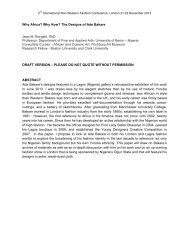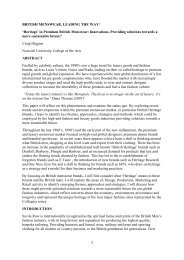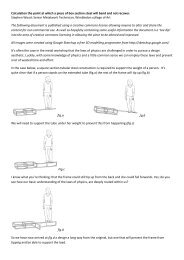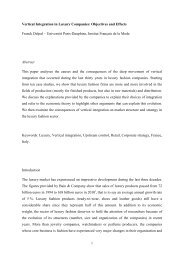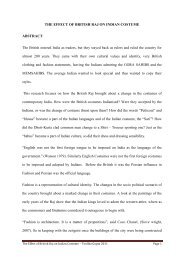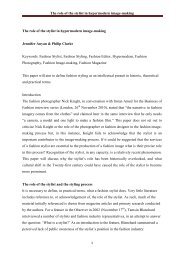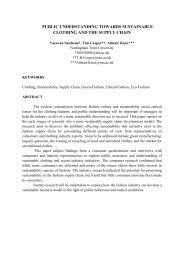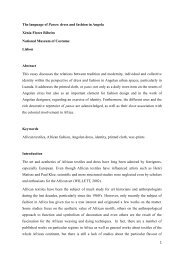1 Abstraction and idealization: the case of Futurist and ... - Arts
1 Abstraction and idealization: the case of Futurist and ... - Arts
1 Abstraction and idealization: the case of Futurist and ... - Arts
Create successful ePaper yourself
Turn your PDF publications into a flip-book with our unique Google optimized e-Paper software.
y Alex<strong>and</strong>er Rodchenko, Varvara Stepanova, Sergein Eisentein, Boris Parsternak, DzigaVertov, Boris Arvatov, Alexei Gan, Liubov Popova etc. From 1927 to 1929 run as Novy LEF(New LEF), to finally be discontinued in 1929 following a dispute over its direction.xxxv Cited, in Italian, in Lidija Zaletova, L‟abito della rivoluzione, Marsilio, Venezia, 1987,pp.175-177.xxxvi „To production!‟ or, following <strong>the</strong> French translation, „A la production!‟, LEF, 1, 1923,pp.105-108; see G. Conio, Le Constructivisme russe, vol.II, Âge d‟homme, Lausanne, 1987,pp.43-44.xxxvii Iskusstvo i proizvodstvo, Proletkul‟t, Moscow, 1926, in B.Arvatov, Kunst undProduktion, Carl Hanser Verlag, Munchen, 1972; <strong>and</strong> in Arte, produzione e rivoluzioneproletaria, edited by H.Gun<strong>the</strong>r <strong>and</strong> K.Hielscher, Guaraldi, Florence <strong>and</strong> Rimini, 1973.xxxviii For an accurate reconstruction <strong>of</strong> <strong>the</strong> ideological debate that gave origin to <strong>the</strong> avantgarderecognizing itself in <strong>the</strong> slogan „art into production‟, see M.Zalambani, „L‟art dans laproduction. Le débat sur le productivisme en Russie pendant les années vingt‟, Annales.Histoire, Sciences Sociales, 1997, 52, 1, pp. 41-61. Taking departure from a closeexamination <strong>of</strong> <strong>the</strong> sources, <strong>the</strong> author demonstrates that <strong>the</strong> <strong>the</strong>oretical path leading toProductivism <strong>and</strong> Constructivism was not an easy one, <strong>and</strong> was ra<strong>the</strong>r strewn withdissensions <strong>and</strong> infighting.xxxix A.Rodchenko, Experiments for <strong>the</strong> Future, edited by A.Lavrentiev <strong>and</strong> J.E.Bowlt, TheMuseum <strong>of</strong> Modern Art, New York, 2005, p.142.xl LEF, 2, 1923, pp.65-68, entirely reproduced, with <strong>the</strong> title „Today‟s Fashion is <strong>the</strong>Worker‟s Overall‟, in L.Zaletova, F.Ci<strong>of</strong>i degli Atti, F.Panzini et al., Revolutionary Costume.Soviet Clothing <strong>and</strong> Textiles <strong>of</strong> <strong>the</strong> 1920s, Rizzoli Publications, New York, 1989, pp.173-174.The title cited in <strong>the</strong> text follows <strong>the</strong> translation proposed by Christina Lodder, RussianConstructivism, Yale University Press, New Haven <strong>and</strong> London, 1983, p.147.xli T.Strizhenova, Moda e Rivoluzione, Electa, Milano, 1979, pp.5-6.xlii At GINKhUK, <strong>the</strong> State Institute for Artistic Culture in Petrograd, Tatlin created models,in particular a workman‟s suit <strong>and</strong> coat, which allowed complete freedom <strong>of</strong> movement <strong>and</strong>responded to <strong>the</strong> new functions that clothing assumed in <strong>the</strong> Constructivist program.Never<strong>the</strong>less, <strong>the</strong>se designs were never industrially produced. The GINKhUK, as reported byTatlin, was concentrated in formulating „clothing norms‟ <strong>and</strong> in discovering „<strong>the</strong> properties <strong>of</strong>materials‟ to provide patterns for production, see V.Tatlin, „Report <strong>of</strong> <strong>the</strong> Section for materialCulture under <strong>the</strong> Museum <strong>of</strong> Artistic Culture to <strong>the</strong> Leningrad Division <strong>of</strong> <strong>the</strong> MainDirectorate <strong>of</strong> Scientific Institution‟, May 1924, in A.Zhadova, Tatlin, Rizzoli IntPublications, London, 1988, p.250xliiiV.Stepanova, „Kostjum segodnjasnego dnja-prozodezhda‟, Lef, 1923, 2, in L.Zaletova,F.Ci<strong>of</strong>i degli Atti, F.Panzini et al., op.cit., p.173.xliv The authorship <strong>of</strong> <strong>the</strong> prozodezhda worn by Rodchenko has been clouded by ambiguity, asChristina Lodder acutely points out. Some, as Strizhenova, imply that <strong>the</strong> prozodezhdafeaturing in <strong>the</strong> photo <strong>of</strong> 1922 was made by Rodchenko himself; never<strong>the</strong>less, <strong>the</strong> samephotograph is reproduced in <strong>the</strong> article O.Beskin „Otvet napravo – zapros nalevo‟, Sovetskoeiskusstvo, 1925, 6, p.8, with <strong>the</strong> apposite caption „V.Stepanova‟ – production clothing‟. SeeC.Lodder, op.cit., p.292, n.8. It is <strong>the</strong>n to be believed that Rodchenko designed that particularoverall, which was actually realized by Stepanova. While Rodchenko‟s overalls were neverproduced <strong>and</strong> ra<strong>the</strong>r remained prototypes, <strong>the</strong> artist was actively involved in making<strong>the</strong>atrical costumes, as those for <strong>the</strong> play Inga by Anatolii Glebov (1929).xlv M. Tupitsyn, „Being-in-production: The Constructivist code‟, in Rodchenko & Popova.Defining Constructivism, edited by M.Tupitsyn, Tate Publishing, London, 2009, p.25.21



